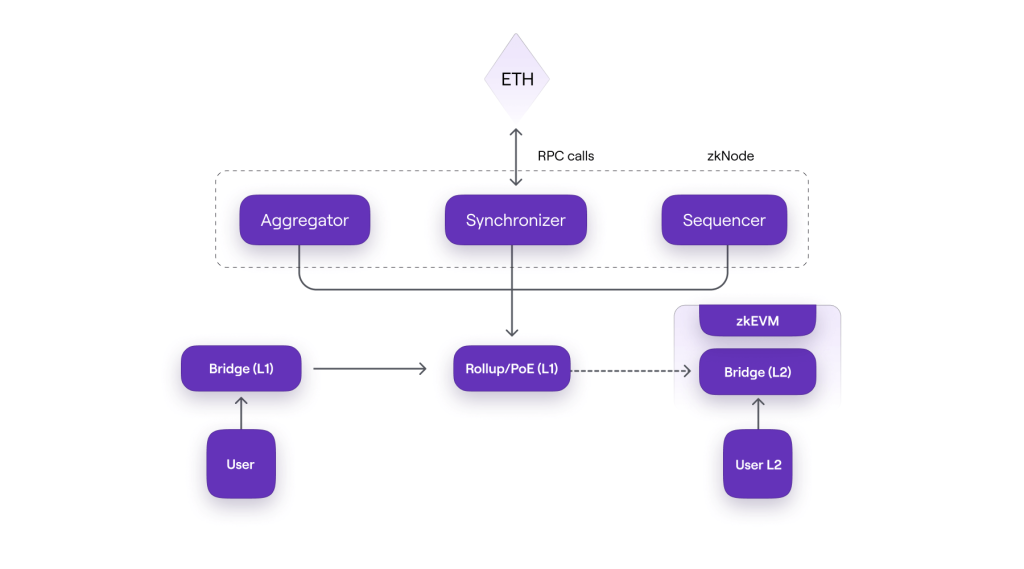Chainstack introduces Polygon zkEVM support

The Chainstack team is thrilled to declare the integration of the Polygon zkEVM protocol into our platform, making it one of our supported chains. This feature enables you to launch a Polygon zkEVM node on any of our subscription plans.
The integration simplifies the process of constructing and expanding DApps using our reliable, enterprise-level infrastructure. This allows you to concentrate more on generating value for your Web3 projects and less on node management.
The new zkEVM L2 requires a strong infrastructure to support the high throughput of the network with the best experience for the DApps. We are pleased to collaborate with Chainstack to make the zkEVM equivalence seamless for users and developers.
David Schwartz – Co-founder Polygon Hermez and Polygon ID
What is Polygon zkEVM?
Over the past few years, several layer 2 solutions have been introduced to enhance the scalability of the Ethereum network, specifically in terms of transaction throughput. These solutions are aimed at reducing gas fees for users of the Ethereum network, while still maintaining decentralization and security.
One of these solutions is the Polygon zkEVM, a layer 2 Rollup solution that combines data availability and execution verification in layer 1 of the Ethereum blockchain to ensure L2 state transition security and reliability.
The infrastructure that Polygon has designed and implemented for its zkEVM, with a particular focus on providing an overview of the components utilized in the development of the zkEVM Protocol is composed of the following:
- Trusted Sequencer
- Trusted Aggregator
- Consensus Contract (PolygonZkEVM.sol, deployed on L1)

Trusted Sequencer
The responsibility of the Trusted Sequencer component is to receive L2 transactions from users, organize them in a particular order, form batches, and then save them to the storage slots of the Consensus Contract in the form of sequences.
After generating the batches, the Sequencer executes and sends them to L2 network nodes for quick finality and to minimize costs that arise due to high network usage. This occurs before the batches are even submitted to L1.
To achieve this, the Trusted Sequencer must operate a zkEVM node in Sequencer mode and possess an Ethereum account that is enforced by the Consensus Contract.
Trusted Aggregator
The Trusted Aggregator component can compute the L2 State by utilizing batches of L2 transactions executed by the Trusted Sequencer.
In contrast, the primary responsibility of the Trusted Aggregator is to receive the L2 batches that have been committed by the Trusted Sequencer and generate Zero-Knowledge proofs that verify the batches’ computational integrity. This is done by the Trusted Aggregator utilizing a special off-chain EVM interpreter.
The Zero-Knowledge proofs are then authenticated by the logic of the Consensus Contract, leading to the zkEVM inheriting the L1 security. Prior to submitting new L2 State roots to the Consensus Contract, validation is necessary. A confirmed proof is indisputable evidence that a specific sequence of batches resulted in a particular L2 state.
To accomplish this task, the Trusted Aggregator must operate a zkEVM node in Aggregator mode and control a particular Ethereum account that is enforced in a Consensus Contract.
Consensus Contract
The contract employed by both the Trusted Sequencer and the Trusted Aggregator in their communication with L1 is known as the PolygonZkEVM.sol contract.
The Trusted Sequencer can submit batch sequences to L1 and save them in the PolygonZkEVM.sol contract, resulting in a chronicle of sequences.
Furthermore, the PolygonZkEVM.sol contract allows the Trusted Aggregator to publicly authenticate the transitions between L2 State roots. The Consensus Contract achieves this by verifying the ZK-proofs provided by the Trusted Aggregator, which attests to the appropriate execution of transaction batches.
Building on Polygon zkEVM
The Polygon zkEVM is an innovative zero-knowledge scaling solution that operates on an equivalent level to the EVM. It supports all current developer tools, smart contracts, and wallets without any issues. With the utilization of zero-knowledge proofs, Polygon zkEVM can considerably reduce transaction expenses and raise throughput while still retaining the security of Ethereum.
Creating decentralized apps on the zkEVM network is identical to that of Ethereum. By transitioning to the zkEVM RPC, developers can easily construct their DApps on a network with improved performance and lower fees. The Polygon zkEVM provides a seamless EVM-like experience for both developers and users, and there’s no need for special tools or new wallets to use or create on the zkEVM network.
Developers have the option of deploying their present contracts to the zkEVM network, and users can deposit their assets from Ethereum and execute off-chain transactions. These transactions are organized into batches, with each transaction’s validity verified by zero-knowledge proof.
zkEVM nodes and execution modes
A zkEVM node is a software bundle that contains all of the necessary components for running a zkEVM network. It can be executed in three distinct modes: Sequencer, Aggregator, or RPC.

Sequencer mode
The node in Sequencer mode performs multiple functions, including holding an instance of L2 State, managing batch broadcasting to other L2 network nodes, and featuring a built-in API to handle L2 user interactions, such as transaction requests and L2 State queries. Additionally, it includes a database to temporarily store pending transactions and all the necessary components to interact with L1 to sequence transaction batches and maintain its local L2 State.
Aggregator mode
When in Aggregator mode, the node possesses all the necessary components to carry out transaction batches, compute the resulting L2 State, and produce Zero-Knowledge proofs of computational integrity. Additionally, it can obtain transaction batches that have been committed in L1 by the Trusted Sequencer and invoke the functions required to publicly validate the L2 State transitions on L1.
RPC mode
When operating in RPC mode, the zKEVM node has a restricted range of functions. Its main role is to maintain an up-to-date instance of L2 State, first with batches that are broadcast by the Trusted Sequencer, and then with sequences of batches obtained from the Consensus Contract. The node regularly interacts with L1 to ensure that its local L2 state is current and to verify the synchronization of L2 state roots. By default, the synchronizer is programmed to synchronize every 2 seconds, unless otherwise specified in the configuration.
Pricing
With Chainstack, you can now optimize your cost efficiency while managing Polygon zkEVM nodes using our robust RPC infrastructure and world-class engineering. You can take advantage of flexible and affordable subscription fees that are tailored to meet your project needs and budget.
The Developer plan offers a commitment-free introduction rate for full elastic nodes, allowing you to leverage the powerful feature set that Polygon zkEVM provides. This subscription also includes up to 3M complimentary requests.
If you need more than just the basics, don’t worry. All of Chainstack’s subscription plans are customized to meet your requirements. You can deploy Polygon zkEVM in a way that is both adaptable and price-competitive, regardless of the size or stage of your project.
With the Growth plan, you’ll have access to 20M requests, which is seven times more than the Developer plan. The Business plan, on the other hand, provides even more requests—140M, which is almost 50x more than the Developer plan, and with no limits for dedicated nodes.
If you reach your request limit, you can simply purchase more at an affordable rate of $10 per 1M requests for the first 20M requests, and then half this price at $5 per 1M requests for those beyond the first 20M. You can try out our pricing calculator here if you need assistance with the math behind it.
Zero-Knowledge L2 scaling with full EVM compatibility
Chainstack is dedicated to delivering optimal value to its users by providing excellent support for each new protocol we add to our family. The addition of Polygon zkEVM was an obvious choice because of its exceptional L2 scaling feature set, paired with Zero-Knowledge proofs for swift transaction processing capabilities. Together, these enable you to explore and apply new opportunities to improve your DApp’s performance.
Polygon’s zkEVM is a game-changer for Web3 enabling fast, secure, and scalable transactions while preserving decentralization. It’s a powerful tool for building the next generation of decentralized applications that can deliver real-world solutions to the world’s most pressing problems. We are thrilled to be among the first to offer support for it and provide developers with ample means of accessing it on the Chainstack platform.
Eugene Aseev, Founder and CTO of Chainstack
With the release of Polygon zkEVM on Chainstack, it’s now easier than ever to leverage the protocol’s exceptional performance with our reliable RPC infrastructure as the foundation. This provides a more seamless experience for Web3 developers like you to BUIDL and scale DApps of any size and stage, making Polygon zkEVM a much more pleasant experience.
Power-boost your project on Chainstack
- Discover how you can save thousands in infra costs every month with our unbeatable pricing on the most complete Web3 development platform.
- Input your workload and see how affordable Chainstack is compared to other RPC providers.
- Connect to Ethereum, Solana, BNB Smart Chain, Polygon, Arbitrum, Base, Optimism, Avalanche, TON, Ronin, zkSync Era, Starknet, Scroll, Aptos, Fantom, Cronos, Gnosis Chain, Klaytn, Moonbeam, Celo, Aurora, Oasis Sapphire, Polygon zkEVM, Bitcoin and Harmony mainnet or testnets through an interface designed to help you get the job done.
- To learn more about Chainstack, visit our Developer Portal or join our Discord server and Telegram group.
- Are you in need of testnet tokens? Request some from our faucets. Multi-chain faucet, Sepolia faucet, Holesky faucet, BNB faucet, zkSync faucet, Scroll faucet.
Have you already explored what you can achieve with Chainstack? Get started for free today.
 Ethereum
Ethereum Solana
Solana TON
TON Base
Base BNB Smart Chain
BNB Smart Chain Sui
Sui Unichain
Unichain Aptos
Aptos TRON
TRON Ronin
Ronin zkSync Era
zkSync Era Sonic
Sonic Polygon
Polygon Gnosis Chain
Gnosis Chain Scroll
Scroll Avalanche Subnets
Avalanche Subnets Polygon CDK
Polygon CDK Starknet Appchains
Starknet Appchains zkSync Hyperchains
zkSync Hyperchains



























